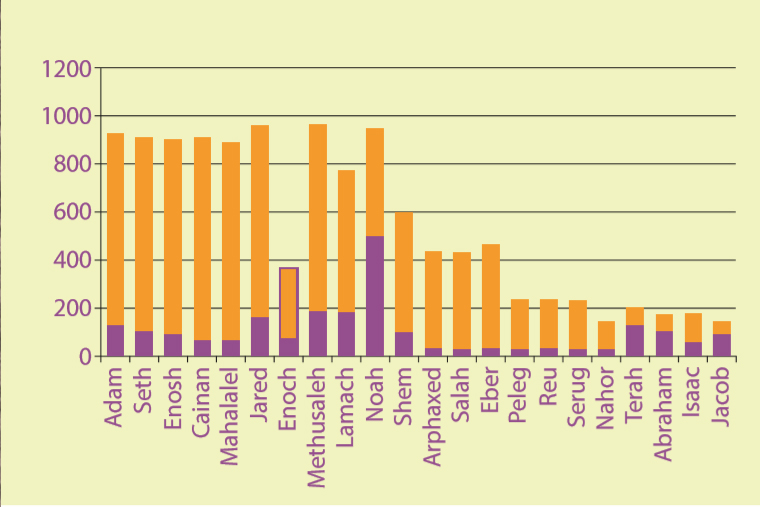Why don’t we live as long as Methuselah?
Extracted from chapters 15 and 24 of The Genesis Account

Probably the most striking feature of Genesis 5 is that our ancestors lived about 10 times longer than people do today; the longest recorded is Methuselah, living for 969 years. This should be believed because God’s Word says it, and He was an eye-witness. Modern science is now shedding light on possible mechanisms.
Fallacious explanation: pre-Flood paradise
Many creationist works from a few decades ago portrayed the antediluvian world as a paradise of sorts, horribly spoiled at the Flood. But this is not taught in Scripture. Furthermore, it obscures the teaching that the big spoiling of paradise occurred at the Fall. This was the time that death, childbirth pain, and thorns and thistles were introduced, when Adam and Eve were tossed out of the Edenic paradise, and when the whole creation started groaning in pain.
However, this pre-Flood paradise idea was very popular, because it supposedly explained how people before the Flood lived for over 900 years, while lifespans dropped exponentially after that. But there is insufficient geological evidence for this view—certainly not enough to overcome its severe problems:
Lamech’s explanation for his naming of his son Noah (5:29) suggests the opposite of a paradisiacal state: “Out of the ground that the Lord has cursed, this one shall bring us relief from our work and from the painful toil of our hands.” Here we have a direct statement that life before the Flood was hard and painful. If a model like ‘pre-Flood paradise’ was meant to be Bible-based, then this consideration alone might be enough to abandon it.
Noah’s lifespan wasn’t shortened despite spending the last third of his life in the alleged ruined environment. The decrease started only with his descendants.
Many fossils show clear evidence of disease, including tumours, gout, and osteoporosis, which hardly supports the idea that it was a healthier environment. Also, some pre-Flood fossilized trees have tree rings that indicate seasonal changes, not a uniformly warm climate. As for the alleged scientific evidence for a pre-Flood paradise, the following will show that it’s not so clear.
Higher atmospheric or oxygen partial pressure?
One idea for the pre-Flood world, derived partly from the fallacious pre-Flood paradise assumption, is that oxygen concentration or atmospheric pressure was higher than today. Indeed, with the abundant plant materials on Earth prior to the Flood (as attested by the huge amounts of coal worldwide) one might not expect the atmospheric concentrations of oxygen and carbon dioxide to be identical to modern values. As will be shown, however, this is not necessary. But the argument is that this higher oxygen partial pressure would have beneficial effects duplicated in today’s hyperbaric chambers.
Yet would this increased oxygen partial pressure be as beneficial as claimed? First, it’s well known that anti-oxidants have proven health benefits. Second, hypoxia (low oxygen) may actually have health benefits. In Russia, intermittent low-oxygen therapy has been used for years to treat conditions like asthma, heart disease and chemotherapy toxicity. Others are trying it for diabetes and chronic fatigue.1 Third, hyperbaric (high pressure) treatments are not always good. Sometimes the opposite—hypobaric treatments—are useful; there is such a thing as Negative Pressure Wound Therapy (NPWT).
To be fair, evolutionists have also proposed higher oxygen concentration or higher atmospheric pressure on Earth in the past, for some of the reasons below.2 Despite being supported by some scientific evidence, this argument does not hold up. The following are the main reasons adduced for higher pre-Flood oxygen:
Higher oxygen levels in amber air bubbles
Bubbles within amber are not a closed system—gases diffuse in and out. Furthermore, contraction under solidification would shrink bubbles, thus raising pressure according to the law named after the creationist ‘father of modern chemistry’, Sir Robert Boyle (1627–1691), that gas pressure is inversely proportional to volume. Also, even the formation of bubbles in itself must increase pressure, to counteract the resistance of surface tension to producing the new surface area of the inside of the bubble.
Pterosaurs needed high pressure to generate enough lift to fly
Previous models of pterosaur flight overlooked the function of the tiny pteroid bone that would have supported a controllable flap. This would greatly increase lift in both takeoff and landing.3,4
Gigantic insects could not have gained enough oxygen under normal pressure

The fossil record shows huge insects such as Meganeuropsis permiana, a dragonfly with a wingspan of 71 cm (28 inches). For a long time, scientists thought that insects didn’t breathe, and oxygen diffused passively through holes (spiracles) through tiny tubes in the abdomen (tracheae). Since this could work only over very short distances, how could such a creature survive without extra oxygen?5 Yet recent synchrotron X-ray microscopy shows that insects really do ‘breathe’ by squeezing the tracheae, such that half the gas is exchanged every second.6,7
Raising some insects in higher oxygen concentration did result in some of them increasing in size, although nothing remotely approaching Meganeuropsis. But some of the insects, such as cockroaches, did not enlarge.8,9
This doesn’t disprove a higher oxygen concentration and air pressure, but it shows that they were not needed scientifically. They are definitely not needed on biblical grounds.
Decreasing lifespans

Since the change in environment is inadequate, in the 1990s, it was proposed that the decline in lifespans had genetic causes.10
Indeed a genetic basis for longevity has been demonstrated in animals, e.g. fruit flies, such that genes for longevity can be lost from a population. Recent research on the accumulation of mutations in the human genome has provided further support for the idea. One of the problems with old-earth belief is that humans add over 30 new mutations every generation. The overwhelming majority of these are not eliminated by natural selection. This should cause an exponential decay in fitness. So if humans had been around for as long as evolutionists claim, we should have become extinct from the huge mutational load. That we have not become extinct is strong evidence that humans have not been here for longer than a few thousand years.11
Recent advanced computer simulations vindicate this proposal, showing that an exponential decay of lifespans fits well with accumulating mutations after the catastrophic population bottleneck at the Flood.12 This can be seen from comparing the decay curve produced by the computer simulation with the recorded lifespans from Noah to the present day (Figure 1).
Why was Shem’s lifespan much shorter than Noah’s?
As shown, genome decay after a population bottleneck explains the general trend of lifespan decay after the Flood. But what about Shem, born before the bottleneck, but he lived only ⅔ as long as most of his ancestors? (The lifespans of his brothers, Ham and Japheth, are not recorded.) There is of course the ever-present possibility in any individual of a non-aging-related cause of death such as disease or accident. But there is also a plausible genetic explanation: he was born when his father was 502, i.e. over half-way through his lifespan. His ancestors were much younger when they fathered their named sons. It has long been known that children born to aged mothers have a higher risk of developing non-hereditary genetic disorders such as Down’s Syndrome, and it is plausible that Mrs Noah was about the same age as Noah. But even if she were much younger, more recent research points to aged fathers as a major source of genetic disorders. This should not be surprising since men keep producing sperm throughout their lives from the division of stem cells (some 840 divisions by age 50).13 In theory, the risks of spontaneous mutation increase with each round of sperm cell division, so the sperm of older men are more likely to carry mutations.14,15
So it is not surprising that Shem, while very fit by today’s standards, would have been considerably less fit than his parents, and carried extra heritable mutations. So Shem and all his descendants had much lower lifespans than the pre-Flood patriarchs.
Conclusion
The recorded lifespans of people pre-Flood, in particular their subsequent drastic decline, are very consistent with recent genetic findings that also severely contradict the idea of a world millions of years old.
References and notes
- Fox, D., Breathless, New Scientist 177(2385)46–49, 8 March 2003; see also Wieland C. and Sarfati, J., Running out of puff: Low oxygen may have medical benefits—implications for the ‘Vapour Canopy’ model, creation.com/puff. Return to text.
- Dudley, R., Atmospheric oxygen, giant Paleozoic insects and the evolution of aerial locomotor performance, J. Experimental Biology 201:1043–1050, 1998. Return to text.
- Wilkinson, M.T., Unwin, D.M.and Ellington, C.P., High lift function of the pteroid bone and forewing of pterosaurs, Proc. R. Soc. 273(1582):119–126, 2006. Return to text.
- Sarfati, J., Pterosaurs flew like modern aeroplanes, Creation 28(3):53, 2006. Return to text.
- Graham, J.B., Dudley, R., Aguilar, N.M. and Gans, C., Implications of the late Palaeozoic oxygen pulse for physiology and evolution, Nature 375(6527):117–120, 1995. This proposes a maximum O2 concentration of 35%. Return to text.
- Westneat, M.W. et al., Tracheal respiration in insects visualized with synchrotron X–ray imaging, Science 299(5606):558–560, 2003. Return to text.
- Catchpoole, D., Insect inspiration solves giant bug mystery, Creation 27(4):44–47, 2005. Return to text.
- Geological Society of America, Raising giant insects to unravel ancient oxygen, Science News, sciencedaily.com, 30 October 2010. Return to text.
- Wieland, C. and Sarfati, J., Some bugs do grow bigger with higher oxygen, J. Creation 25(1):13–14, 2011. Return to text.
- Wieland, C., Decreased lifespans: Have we been looking in the right place? J. Creation 8(2):138–141, 1994. Return to text.
- Sanford, J.C., Genetic entropy and the mystery of the genome, Ivan Press, Lima, NY, 2005; see review by Truman, R., J. Creation 21(1):43–47, 2007. Return to text.
- Sanford, J.C., Baumgardner, J.R., Brewer, W.H., Gibson, P. and ReMine, W.R., Mendel’s Accountant: A biologically realistic forward-time population genetics program, Scalable Computing: Practice and Experience 8(2):147–165, June 2007. Return to text.
- Buwe, A. et al., Effect of paternal age on the frequency of cytogenetic abnormalities in human spermatozoa, Cytogenet. Genome Res. 111:213–228, 2005. Return to text.
- Green, R.F., Association of paternal age and risk for major congenital anomalies from the National Birth Defects Prevention Study, 1997 to 2004, Ann. Epidemiol. 20(3):241–249, 2010. Return to text.
- Schubert, C., Male biological clock possibly linked to autism, other disorders, Nature Medicine 14:1170, 2008. Return to text.







Readers’ comments
Comments are automatically closed 14 days after publication.